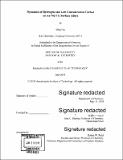Dynamics of hydrogen and low concentration carbon on Au-Ni(111) surface alloys
Author(s)
Liu, Qing, Ph. D. Massachusetts Institute of Technology
DownloadFull printable version (23.08Mb)
Other Contributors
Massachusetts Institute of Technology. Department of Chemistry.
Advisor
Sylvia T. Ceyer.
Terms of use
Metadata
Show full item recordAbstract
Exposure of Au-Ni(111) surface alloys to molecular hydrogen results in the dissociative chemisorption of hydrogen to produce H atoms adsorbed on two distinct types of threefold hollow sites, as identified via thermal desorption spectroscopy (TDS), collision induced recombinative desorption (CIRD), and high resolution electron energy loss spectroscopy (HREELS). Hydrogen atoms bind relatively strongly to threefold hollow sites consisting only of Ni atoms, with a binding energy of 63 kcal/mol and characteristic vibrational frequencies of 970 and 1170 cm-¹. Hydrogen atoms bind relatively weakly to threefold hollow sites consisting of two Ni atoms and one Au atom, with a binding energy of 55 kcal/mol and characteristic vibrational frequencies of 820 and 1050 cm'. Alloying of Au into the Ni(l 11) surface reduces the amount of chemisorbed H upon molecular H2 exposure, but promotes the formation of bulk H upon atomic H exposure, compared to a Ni(111) surface. A robust algorithm for determining the Au coverage of Au-Ni(111) surface alloys using Auger electron spectroscopy is also developed. The observation of three vibrational features at 750, 1470, and 2220 cm-¹ in the HREEL spectra of purportedly clean Au-Ni(111) surface alloys is reported. These features are attributed to graphene, formed on the Au-Ni(111) surface alloys via segregation of very small amounts of residual carbon in the bulk. The alloyed Au atoms destabilize the carbide phase and promote the nucleation and growth of graphene. The features at 750 and 1470 cm-1 are assigned as the ZO and LO (TO) phonon modes of graphene, respectively. The feature at 2200 cm-¹ is tentatively assigned as a two-phonon (ZO + LO/TO) mode. An additional feature at 2990 cm-¹ is identified as the stretching mode of C-H bonds, formed through the interaction between water or hydrogen from the vacuum chamber background pressure and the dangling bonds of carbon atoms along the edges of graphene. The feature at 3670 cm-¹ is the O-H stretching mode of isolated water molecules or hydroxyl groups. The addition of Au weakens the interaction between the metal d band and graphene [pi] state, resulting in a stiffening of the ZO mode by 30 ~ 60 cm-', compared to graphene-Ni(111). The softening of the LO (TO) mode by 30 cm-¹ arises from the slightly larger unit cell of graphene adsorbed on Au-Ni(1 11) as compared to that on Ni(111).
Description
Thesis: Ph. D. in Physical Chemistry, Massachusetts Institute of Technology, Department of Chemistry, 2018. Cataloged from PDF version of thesis. Includes bibliographical references.
Date issued
2018Department
Massachusetts Institute of Technology. Department of ChemistryPublisher
Massachusetts Institute of Technology
Keywords
Chemistry.